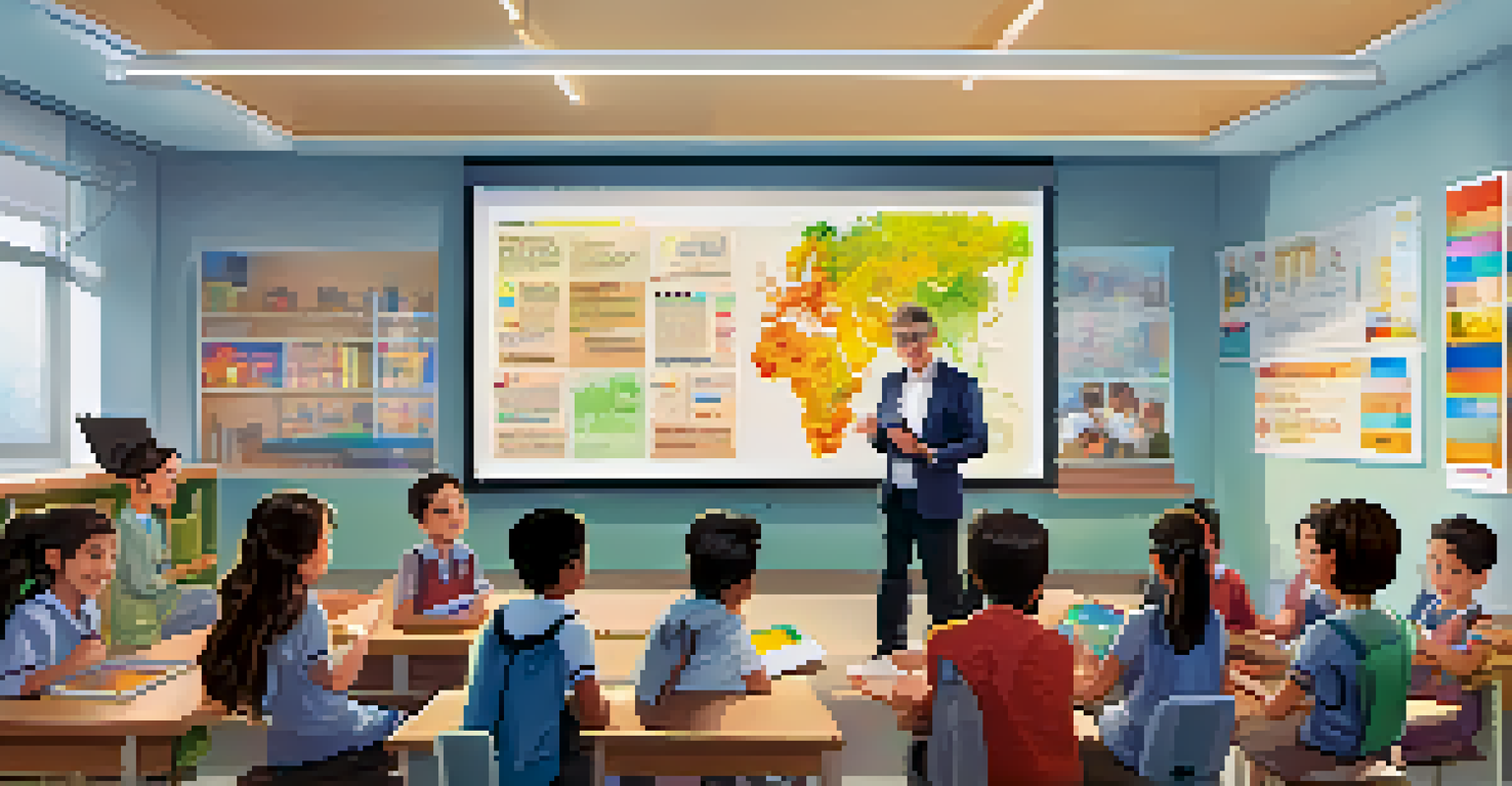Intercultural Communication: Bridging Gaps in Education

Understanding Intercultural Communication in Education
Intercultural communication refers to how people from different cultures communicate, often navigating language barriers and diverse social norms. In education, this concept becomes crucial as classrooms are increasingly multicultural. Understanding these dynamics helps educators create inclusive environments where all students feel valued.
The single biggest problem in communication is the illusion that it has taken place.
For example, a teacher who recognizes the varying communication styles of their students can tailor their approach to meet diverse needs. This might involve adjusting classroom discussions or incorporating different cultural perspectives into the curriculum. By doing so, educators not only enhance learning but also foster respect among students.
Ultimately, understanding intercultural communication is about more than just language; it's about recognizing and appreciating differing viewpoints. This awareness helps bridge gaps and nurtures a sense of belonging—essential elements for effective learning.
The Role of Cultural Awareness in Classrooms
Cultural awareness is the ability to recognize and understand the differences and similarities between cultures. In the classroom, this awareness can significantly influence student engagement and success. When teachers demonstrate cultural sensitivity, they help students feel more comfortable and included.

Consider a classroom where a teacher integrates stories and examples from various cultures into lessons. This not only enriches the curriculum but also validates the experiences of students from those backgrounds. It creates an environment where all students are encouraged to share their perspectives, enhancing collective learning.
Intercultural Communication Matters
Understanding intercultural communication enhances inclusivity and respect in increasingly multicultural classrooms.
By fostering cultural awareness, educators can challenge stereotypes and misconceptions, paving the way for deeper understanding. This approach cultivates empathy among students, teaching them to appreciate diversity as a strength rather than a barrier.
Barriers to Effective Intercultural Communication
Despite the benefits, several barriers can hinder effective intercultural communication in educational settings. These barriers often include language differences, preconceived notions, and varying communication styles. For instance, a student who is shy may struggle to participate in discussions if they feel their contributions won’t be understood.
Diversity is not a reason for division; it is a reason for celebration.
Moreover, cultural misunderstandings can arise when educators are unaware of specific cultural norms. For example, in some cultures, direct eye contact may be seen as disrespectful. Such nuances can lead to misinterpretations, making it essential for educators to recognize these differences.
Addressing these barriers requires ongoing training and openness among educators. By actively seeking to understand their students' backgrounds, teachers can build stronger connections, ultimately enhancing communication and learning outcomes.
Strategies for Enhancing Intercultural Communication
To promote effective intercultural communication, educators can implement several strategies. One effective method is to incorporate collaborative projects that require students from different backgrounds to work together. This interaction fosters relationships and builds communication skills while promoting cultural exchange.
Another strategy is to use technology to bridge communication gaps. Tools like translation apps or online forums can facilitate discussions among students who speak different languages. In this way, technology becomes a powerful ally in breaking down barriers.
Cultural Awareness Boosts Engagement
Fostering cultural awareness in education leads to greater student engagement and empathy among peers.
Additionally, encouraging students to share their cultural backgrounds can create a rich learning environment. When students present their traditions or customs, it not only educates their peers but also fosters mutual respect and curiosity.
The Impact of Intercultural Communication on Student Engagement
Effective intercultural communication can significantly boost student engagement in the classroom. When students feel understood and valued, they are more likely to participate actively in discussions. This engagement leads to a more dynamic learning environment where ideas can flourish.
For example, a culturally inclusive classroom that celebrates diversity can motivate students to share their thoughts and experiences. This not only enriches their educational experience but also helps them develop critical thinking and communication skills.
Moreover, engaged students are more likely to collaborate with their peers, enhancing their social skills and fostering a sense of community. This interconnectedness is essential for building a supportive learning atmosphere.
Building Empathy Through Intercultural Communication
Empathy is a crucial component of effective intercultural communication, especially in education. By encouraging students to understand and appreciate different perspectives, educators help them develop empathy. This skill is vital not only for academic success but also for fostering meaningful relationships.
For instance, role-playing activities can allow students to step into the shoes of their peers from different cultures. By experiencing situations from another's perspective, students can better understand the challenges and triumphs of their classmates, promoting compassion.
Overcoming Communication Barriers
Addressing barriers to effective communication is essential for creating strong connections between educators and students.
Ultimately, building empathy through intercultural communication prepares students for a diverse world. It equips them with the skills needed to navigate complex social landscapes, enhancing their personal and professional relationships in the future.
The Future of Intercultural Communication in Education
As globalization continues to shape our world, the importance of intercultural communication in education will only grow. Schools must adapt to these changes by fostering inclusive environments that prioritize understanding and collaboration. This shift can help prepare students for a multicultural workforce that values diverse perspectives.
Educators will need to embrace ongoing professional development to stay informed about best practices in intercultural communication. This commitment to growth ensures that they can effectively address the needs of all students, creating a more equitable education system.

Looking ahead, we can envision classrooms that celebrate diversity and promote intercultural understanding as core values. By bridging communication gaps today, we can cultivate a more harmonious and inclusive future for generations to come.